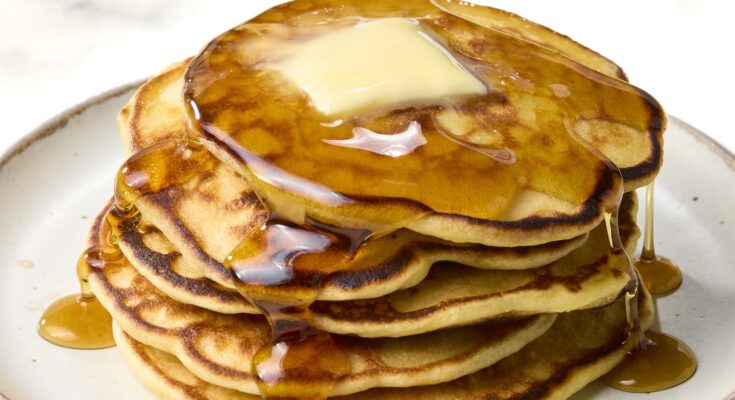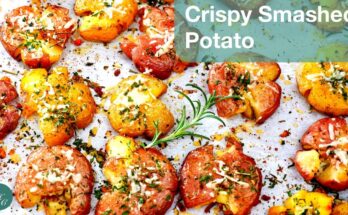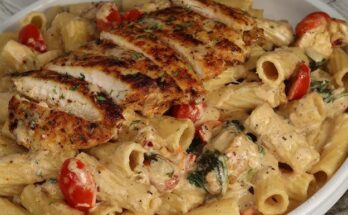Best Pancakes Recipe: Let’s be honest—there’s nothing quite like waking up to a stack of golden, fluffy pancakes dripping with warm syrup and a dollop of melting butter. Pancakes are more than just a breakfast item; they’re a comforting tradition, a weekend treat, and a canvas for endless creativity. Whether you’re craving something sweet or looking for a hearty start to your day, pancakes never disappoint.
What makes pancakes so beloved across the world? It’s their simplicity and adaptability. You can whip them up with ingredients you likely already have at home, and yet with just a few tweaks, you can transform them into gourmet-style delights. Think blueberry pancakes bursting with fruit, or rich chocolate chip ones that melt in your mouth. Pancakes offer comfort, nostalgia, and an easy way to bring the family together around the table.
This step-by-step guide is your go-to resource for making the best pancakes ever—from mixing your batter just right to flipping them at the perfect moment. Whether you’re a newbie in the kitchen or a seasoned cook wanting to perfect your technique, this guide is designed to help you master the ultimate pancake recipe.
Essential Ingredients for the Best Pancakes
Let’s talk ingredients—the building blocks of pancake perfection. Getting the basics right makes all the difference. Here’s a rundown of what you’ll need and why each ingredient is crucial.
1. All-purpose flour: This is the backbone of your pancakes. It provides structure and fluffiness. You can experiment with whole wheat flour or gluten-free blends, but for classic pancakes, stick to all-purpose.
2. Baking powder: This little leavening agent is what gives your pancakes their rise. It creates bubbles that help the batter puff up beautifully on the griddle.
3. Sugar: A tablespoon or two adds a subtle sweetness. It also helps the pancakes brown better during cooking.
4. Salt: Don’t skip it! A pinch of salt enhances all the other flavors and balances the sweetness.
5. Milk: The liquid that brings it all together. Whole milk is ideal for richness, but any kind will do—dairy or non-dairy.
6. Eggs: These bind the ingredients and contribute to the pancakes’ fluffy texture. They also add richness and color.
7. Butter (melted): For that irresistible flavor and a tender crumb. You can also use oil, but butter gives the best taste.
8. Vanilla extract (optional): A splash of vanilla takes your pancakes from good to amazing.
Once you’ve got these essentials down, you can start experimenting—try adding blueberries, cinnamon, or even protein powder for a healthy twist. But the base recipe? It starts here, and it’s where the magic begins.
Tools You Need to Make Pancakes Like a Pro
You don’t need a fancy kitchen to make incredible pancakes. Still, having the right tools can make the process smoother and more enjoyable.
Must-Have Tools:
- Mixing bowls: You’ll need at least two—one for dry ingredients and one for wet.
- Measuring cups and spoons: Accuracy matters, especially for baking basics like flour and baking powder.
- Whisk: To mix the batter without overworking it.
- Non-stick skillet or griddle: This is key to even cooking and easy flipping. Cast iron is also a great choice if seasoned well.
- Spatula: A good-quality spatula is your pancake-flipping best friend.
Nice-to-Have Extras:
- Ladle or measuring cup (for pouring batter): Keeps pancake sizes consistent.
- Cooling rack: Helps pancakes stay crisp if you’re making a big batch.
- Electric griddle: Perfect if you’re cooking for a crowd—it holds a steady temperature and cooks multiple pancakes at once.
Having these tools on hand won’t just make cooking easier—they’ll help ensure that each pancake you serve is golden brown, fluffy, and absolutely delicious.
Step-by-Step Guide to Making Perfect Pancakes
Alright, it’s time to get into the heart of the matter. Let’s make some pancakes!
Step 1 – Prepare Your Ingredients
Before you even think about turning on the stove, get everything set. Measure out your flour, baking powder, salt, sugar, and place them in a bowl. In another bowl, crack your eggs, pour in the milk, melted butter, and vanilla extract if you’re using it.
This “mise en place” approach keeps you organized and helps avoid mistakes like forgetting an ingredient or adding something twice. Pro tip: Make sure your milk and eggs are at room temperature. This helps the batter mix more evenly and results in fluffier pancakes.
Step 2 – Make the Pancake Batter
Now, gently combine the wet ingredients into the dry ingredients. Use a whisk, but don’t go overboard—this is where many people go wrong. You want the batter to be just combined. It’s okay if there are a few lumps; they’ll cook out. Overmixing develops gluten, which can lead to tough, rubbery pancakes.
The key here is balance—mix until you no longer see dry flour, then stop. Think of it as folding a soft pillow—you want it light and airy, not squashed and dense.
Step 3 – Let the Batter Rest
Now here’s a step many skip—but it’s absolutely worth the extra patience. Let your pancake batter rest for at least 10 to 15 minutes. Why? Resting allows the gluten in the flour to relax and gives the baking powder more time to activate. This results in lighter, fluffier pancakes with a tender crumb.
Think of it like giving your batter a nap before it hits the heat. If you cook it too soon, the pancakes might come out dense or chewy. During this time, tiny bubbles will begin to form in the batter—those are your little fluff-makers at work!
If you’re in a rush, you can skip this step, but if you want diner-quality pancakes at home, trust us—just wait. If you’re prepping ahead of time, you can even make the batter and store it covered in the fridge overnight.
Step 4 – Preheat Your Pan or Griddle
This step is simple but crucial. A properly heated pan or griddle ensures that your pancakes cook evenly and develop that golden-brown crust we all crave.
How do you know it’s ready? Drop a few drops of water onto the surface. If they sizzle and evaporate immediately, you’re good to go. Set the heat to medium—too hot and your pancakes will burn on the outside while staying raw inside; too cool and they’ll be pale and flat.
Lightly grease the pan with butter or oil, then wipe off the excess using a paper towel. This helps the first pancake cook evenly without soaking in grease.
Pro tip: Use a non-stick skillet or a well-seasoned cast iron pan. If you’re cooking multiple pancakes, an electric griddle is perfect—it keeps a consistent temperature and gives you more space.
Step 5 – Cook the Pancakes
Now the fun begins! Pour about 1/4 cup of batter onto the preheated pan for each pancake. Use a ladle or a measuring cup to keep things consistent.
Don’t overcrowd the pan—give each pancake room to spread and cook. Let them cook for about 2 to 3 minutes, or until you see bubbles forming on the surface and the edges start to look set. That’s your cue.
During this time, resist the urge to peek or poke. Let the batter do its thing. Cooking pancakes is a bit like roasting marshmallows—low and slow gets the best results.
If you’re adding mix-ins like blueberries or chocolate chips, sprinkle them on top right after you pour the batter into the pan. That way, they don’t sink or burn.
Step 6 – Flip and Finish Cooking
Here comes the most satisfying part—the flip. Once those bubbles have popped and the edges are looking dry, slide your spatula gently underneath the pancake. Lift slightly to check the bottom. If it’s golden brown, you’re ready.
Use a confident wrist flick to flip it over. Let the second side cook for another 1 to 2 minutes until golden and cooked through.
Place the finished pancakes on a wire rack or plate lined with a paper towel to keep them warm while you cook the rest. Avoid stacking them immediately if you’re making a lot—they’ll get soggy from the steam.
And just like that, you’ve got a perfect batch of pancakes—crispy on the outside, fluffy on the inside, and just waiting to be devoured.
Topping Ideas to Elevate Your Pancakes
Pancakes are a blank canvas—what you put on them can turn a simple breakfast into an unforgettable experience. Here are some creative and delicious ideas:
Sweet Toppings:
- Classic maple syrup and butter – always a winner
- Fresh fruits – strawberries, blueberries, bananas, or peaches
- Whipped cream – because why not?
- Nut butters – peanut, almond, or hazelnut spread
- Honey or agave syrup – for a natural sweetener twist
Savory Options:
- Fried egg and bacon – sweet and salty heaven
- Avocado slices with chili flakes
- Cheese and herbs – cheddar with chives is a great combo
Healthy Twists:
- Greek yogurt with honey and walnuts
- Chia seeds and sliced fruit
- Cottage cheese and berries
Get creative with your combinations. Try building a pancake tower with different layers of toppings—it’s like breakfast and dessert in one.
Common Pancake Mistakes and How to Avoid Them
Let’s face it—even experienced cooks can mess up pancakes. But the good news? Most mistakes are easy to fix once you know what to look out for. Here are the most common pancake fails and how to avoid them:
1. Overmixing the Batter
This is pancake mistake #1. When you mix your batter too much, the gluten in the flour develops too much, leading to dense, rubbery pancakes. Remember: a few lumps are totally okay. Stir just until the flour disappears into the wet mix.
2. Using Cold Ingredients
Cold milk, eggs, or melted butter can shock your batter and prevent even cooking. Always bring ingredients to room temperature before mixing. It only takes about 10–15 minutes, and the payoff is huge.
3. Skipping the Rest Time
Impatience is your pancake’s enemy. Letting the batter rest gives the flour time to absorb the liquids and the baking powder time to activate. It makes for fluffier, more tender pancakes.
4. Cooking on the Wrong Heat
Too hot, and your pancakes burn before cooking through. Too low, and they’ll be pale and dense. Aim for medium heat, and always preheat the pan before adding batter.
5. Flipping Too Soon (or Too Often)
You should only flip your pancake once. Flip too early, and it’ll fall apart. Flip too often, and it’ll deflate. Wait until bubbles form on top and the edges start to dry out—that’s your perfect flipping moment.
6. Not Greasing the Pan Properly
Using too much oil can make pancakes greasy. Not enough and they’ll stick. Use a small amount of butter or oil, then wipe with a paper towel to create a thin, even coating.
Avoid these pitfalls, and you’re on your way to pancake greatness every time.
Tips for Fluffier, Tastier Pancakes Every Time
Want pancakes so fluffy they bounce on the plate? These simple hacks will make a big difference in your final stack.
Use Buttermilk Instead of Regular Milk
Buttermilk adds a tangy flavor and reacts beautifully with baking powder to create more rise. If you don’t have buttermilk, you can make your own by adding 1 tablespoon of vinegar or lemon juice to 1 cup of milk—let it sit for 5 minutes before using.
Separate and Whip the Egg Whites
This tip takes a little extra effort but is totally worth it. Separate your eggs and whip the egg whites until soft peaks form. Then fold them into your batter just before cooking. The air trapped in the egg whites gives your pancakes a dreamy, airy texture.
Don’t Be Afraid of Fat
A little melted butter or oil in your batter helps keep pancakes tender and flavorful. If you’re going low-fat, try applesauce or mashed banana instead—they add moisture and a hint of sweetness.
Add a Dash of Baking Soda
Even if your recipe calls for baking powder, a small amount of baking soda can react with acidic ingredients like buttermilk or yogurt to create extra fluffiness.
Keep Your Pan Temperature Consistent
A too-hot pan will burn the outside before the inside cooks. Between batches, reduce the heat slightly and let your pan cool for a few seconds. You can also wipe out burnt butter and reapply a light coating of fresh oil.
Use a Sifter for Your Dry Ingredients
Sifting flour, baking powder, and sugar before mixing helps distribute them evenly and adds air into the mix, which contributes to a lighter batter.
Incorporate these small adjustments and your pancakes will go from “good” to “legendary.”
FAQs about Pancakes Recipe
1. Can I freeze pancakes?
Yes! Cook and cool them completely, then layer between parchment paper and store in a freezer-safe bag. To reheat, pop them in the toaster or microwave until warm.
2. What can I substitute for eggs in pancakes?
Try mashed banana, applesauce, yogurt, or a flaxseed mixture (1 tbsp flaxseed + 3 tbsp water). Each gives a slightly different flavor and texture.
3. How do I make vegan pancakes?
Use plant-based milk, egg substitutes like flax or chia seeds, and dairy-free butter or oil. Add vanilla and a little sugar for flavor.
4. Can I make the batter ahead of time?
Yes, but use it within 24 hours. Store covered in the fridge. Just know the baking powder may lose some potency, so you might need to stir in a pinch before cooking.
5. Why are my pancakes rubbery?
Overmixing is the likely culprit. Stir your batter just until the ingredients are combined. A few lumps are totally fine—and even ideal.
Conclusion
The beauty of pancakes is that they welcome experimentation. Once you master the basics—getting the batter just right, cooking at the perfect temperature, flipping like a pro—you can start exploring endless variations. Try different flours, toss in your favorite mix-ins, or even swap out ingredients to fit your dietary needs.
The next time you’re looking to impress a guest, treat your family, or simply pamper yourself on a lazy Sunday, whip up a batch of these perfect pancakes. Serve them warm, stack them high, and enjoy every bite.
Remember: a great day starts with great pancakes.



